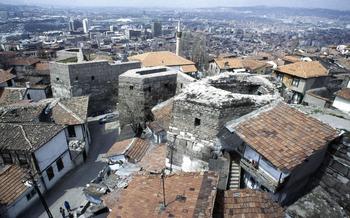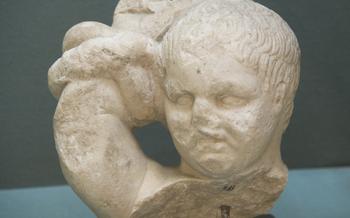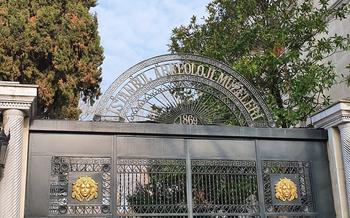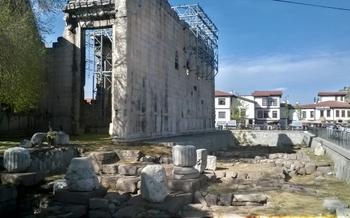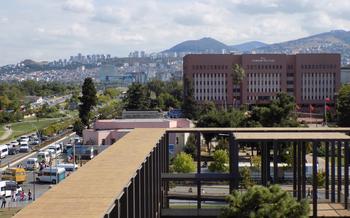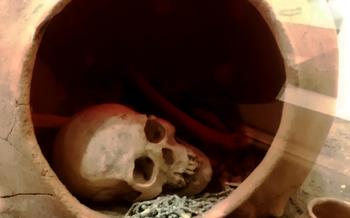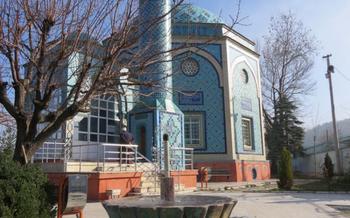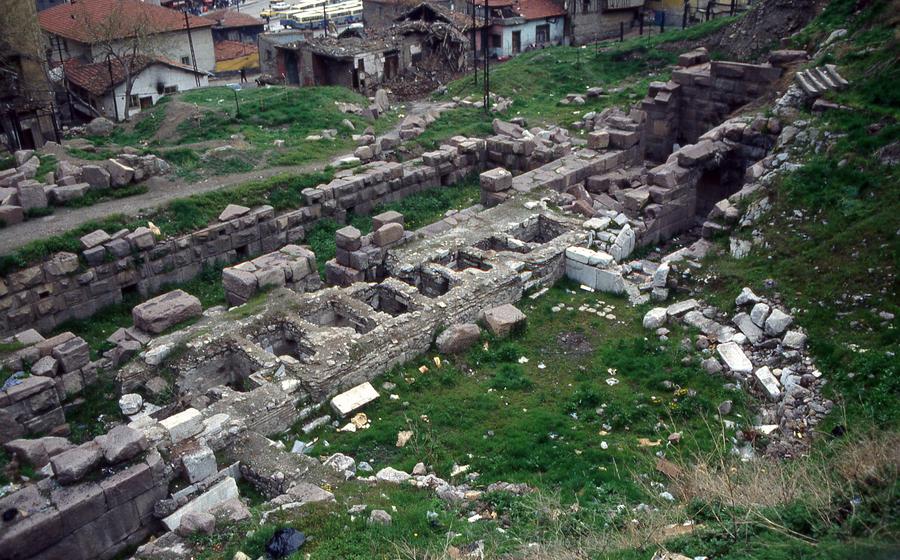
Ankara Roman Theatre
- Ankara Roman Theatre: A Historical Masterpiece
- Location and Getting There
- Hours of Operation and Ticket Information
- Guided Tours and Audio Guides
- Exploring the Theatre's Architecture
- Immerse Yourself in Ancient Performances
- Events and Festivals at the Theatre
- The Theatre's Historical Significance
- Nearby Attractions and Points of Interest
- Photography and Videography Guidelines
- Accessibility for Visitors with Disabilities
- Tips for a Memorable Visit
- Capture the Ancient Ambience
- Step Back in Time with Historical Reenactments
- Insider Tip: Unveiling Hidden Gems
Ankara Roman Theatre: A Historical Masterpiece
The Ankara Roman Theatre is an awe-inspiring testament to the grandeur and artistry of the ancient Roman Empire. Built in the 2nd century AD during the reign of Emperor Hadrian, this magnificent structure once hosted a variety of performances, from plays and concerts to gladiator fights. Its impressive architecture, featuring a well-preserved stage and intricate carvings, transports visitors back in time, offering a glimpse into the vibrant cultural life of ancient Ancyra.
History: The theatre's origins date back to the Roman period when the city of Ancyra, now known as Ankara, served as a significant provincial capital. Constructed around 150 AD, the theatre played a crucial role in the city's cultural and social life. It hosted a wide range of events, including theatrical performances, musical concerts, and gladiatorial contests, providing entertainment and spectacle to the Roman citizens.
Architecture: The Ankara Roman Theatre is a remarkable example of Roman engineering and architectural prowess. Built using local limestone, the theatre features a classic design with a semi-circular seating arrangement, a spacious orchestra, and an impressive stage adorned with intricate carvings and sculptures. Its well-preserved state offers a glimpse into the architectural techniques and artistic sensibilities of the ancient Romans.
Performances: The theatre's versatility allowed it to host a diverse range of performances, catering to the varied interests of the Roman population. Plays, concerts, recitals, and even gladiator fights were staged within its walls, providing entertainment and spectacle to the masses. The theatre's acoustics were carefully designed to enhance the performances, ensuring that every word and sound reached the audience with clarity.
Preservation: Over the centuries, the Ankara Roman Theatre has undergone extensive restoration and preservation efforts to maintain its grandeur and historical significance. Excavations conducted in the 1930s unearthed valuable artifacts and shed light on the theatre's rich history. Today, the theatre stands as a testament to the enduring legacy of the Roman Empire and serves as a vibrant cultural venue for various events and performances.
Location and Getting There
The Ankara Roman Theatre is conveniently located in the heart of the city, making it easily accessible for visitors. Its exact address is Hisarpark, Ankara Kalesi, Altındağ/Ankara. To reach the theatre, you can take advantage of Ankara's efficient public transportation system. Several bus lines, including the 412 and 413, stop within walking distance of the theatre. If you prefer to drive, there are limited parking options available in the vicinity, but it's recommended to use public transportation or taxis to avoid any parking challenges.
Hours of Operation and Ticket Information
The Ankara Roman Theatre is open to visitors throughout the week, offering ample opportunities for exploration and discovery. During weekdays, the theatre is accessible from 8:00 AM to 5:00 PM, allowing visitors to immerse themselves in its ancient grandeur without the hustle and bustle of large crowds. On weekends, the theatre extends its hours of operation, remaining open from 9:00 AM to 6:00 PM, providing visitors with additional time to explore its captivating ruins.
Ticket prices vary depending on the visitor's age and status. Adults can purchase tickets for 60 Turkish Lira, while children between the ages of 6 and 12 can enter for a reduced fee of 30 Turkish Lira. Students with valid identification are also eligible for discounted tickets, priced at 30 Turkish Lira.
To enhance the visitor experience, the Ankara Roman Theatre offers several discounts and special offers. Visitors who purchase tickets online or through authorized tour operators may be eligible for discounted rates. Additionally, the theatre occasionally hosts promotional events and offers group discounts for larger parties, making it an affordable and accessible attraction for all.
Guided Tours and Audio Guides
The Ankara Roman Theatre offers guided tours in various languages, allowing visitors to delve deeper into its history, architecture, and significance. These tours are conducted by knowledgeable guides who provide insights into the theatre's past and present. Visitors can choose from a range of tour options, depending on their interests and time constraints.
Audio guides are also available for those who prefer a self-guided experience. These audio guides offer detailed commentary on the theatre's various features, allowing visitors to explore at their own pace. The audio guides are available in multiple languages, ensuring that visitors from different countries can access the information.
To book a guided tour or audio guide, visitors can approach the ticket counter at the theatre or make reservations in advance through the theatre's official website. The cost of guided tours and audio guides varies depending on the option chosen and the number of participants. Booking in advance is recommended, especially during peak tourist seasons, to avoid any disappointment.
Exploring the Theatre's Architecture
The Ankara Roman Theatre showcases remarkable architectural features that have withstood the test of time. The theatre's seating arrangement, known as the cavea, is divided into three distinct sections: the ima cavea, media cavea, and summa cavea. These sections are separated by horizontal aisles called diazomata. The ima cavea, located at the bottom, was reserved for officials and honored guests, offering the best view of the stage. The media cavea and summa cavea accommodated the general public.
The theatre's impressive stage, known as the proscaenium, features a raised platform and a backdrop decorated with intricate carvings and sculptures. The stage is flanked by two projecting wings, or parascenia, which served as changing rooms for performers. The original wooden stage floor has been replaced with a modern concrete surface, preserving the theatre's structure while allowing for contemporary performances.
The theatre's construction materials reflect the engineering prowess of the Romans. The cavea is built using local limestone, while the stage and other structural elements are constructed from a combination of limestone, brick, and marble. The use of these durable materials has contributed to the theatre's longevity and resilience.
Restoration efforts have played a crucial role in preserving the theatre's original features. Over the years, archaeological excavations and restoration projects have been undertaken to uncover hidden sections, repair damaged structures, and reinforce the theatre's stability. These efforts have ensured that the Ankara Roman Theatre remains a well-preserved monument to ancient Roman architecture and engineering.
Immerse Yourself in Ancient Performances
The Ankara Roman Theatre was not just a place of construction but a stage for diverse and captivating performances. It was one of the main venues for the city's vibrant cultural scene during Roman times. The theatre hosted a wide range of performances, including plays, concerts, and festivals.
The performances held in the theatre were often grand and elaborate, featuring talented actors, musicians, and dancers. The acoustics of the theatre were exceptional, ensuring that the actors' voices and the musicians' melodies could be heard clearly throughout the auditorium. This created a unique and immersive atmosphere that transported the audience to another time and place.
Attending a performance in the Ankara Roman Theatre was a truly special experience for the people of ancient Ancyra. It was an opportunity to come together, be entertained, and celebrate their shared culture. The theatre's performances played a vital role in shaping the city's cultural identity and fostering a sense of community.
Events and Festivals at the Theatre
The Ankara Roman Theatre is not just a historical monument but also a vibrant venue for cultural events and festivals. Throughout the year, the theatre hosts a diverse range of performances that bring the ancient stage back to life.
One of the most popular annual events is the Ankara International Music Festival, which attracts renowned musicians and performers from around the world. The festival features a variety of musical genres, from classical to contemporary, and creates a magical atmosphere within the ancient theatre.
Another highlight is the Ankara Theatre Festival, which showcases both local and international theatre productions. The festival presents a wide range of plays, from ancient Greek tragedies to modern dramas, offering theatre enthusiasts a unique opportunity to experience the power of live performances in a historical setting.
In addition to these major events, the theatre also hosts regular concerts, dance performances, and cultural festivals. These events provide a platform for local artists to showcase their talents and celebrate Turkish culture and traditions.
For those interested in attending an event at the Ankara Roman Theatre, it is advisable to check the theatre's official website or contact the box office for information on upcoming events and ticket availability. Advance booking is recommended to avoid disappointment, especially for popular events.
The Theatre's Historical Significance
The Ankara Roman Theatre holds immense historical significance, serving as a testament to the grandeur and cultural heritage of the ancient city of Ancyra and the Roman Empire. Constructed during the reign of Emperor Augustus in the 1st century AD, the theatre played a pivotal role in the religious and social life of the city. It served as a venue for theatrical performances, gladiator fights, and other public spectacles, showcasing the rich cultural traditions of the Roman Empire.
As part of the Roman province of Galatia, Ancyra flourished as a major trade and administrative center. The theatre's strategic location within the city's urban fabric reflects its importance as a civic and cultural hub. The theatre's well-preserved remains provide valuable insights into the architectural and engineering prowess of the Romans, demonstrating their mastery in constructing monumental structures that have withstood the test of time.
Over the centuries, the theatre has witnessed numerous historical events, from the rise and fall of empires to the evolution of artistic expressions. Its enduring presence serves as a reminder of Ankara's rich past and its continuous role as a cultural crossroads. Today, the Ankara Roman Theatre stands as a symbol of the city's historical legacy, attracting visitors from around the world who seek to explore the depths of its ancient heritage.
Nearby Attractions and Points of Interest
Museums:
- Museum of Anatolian Civilizations:
- Explore the rich history and cultural heritage of Anatolia through artifacts from various civilizations, including Hittites, Phrygians, and Romans.
- Marvel at the exquisite collection of sculptures, pottery, and jewelry that tell the story of ancient Anatolian civilizations.
Historical Sites:
- Ankara Citadel:
- Embark on a journey through time as you explore the ancient fortress that once served as the heart of Ankara.
- Discover the remnants of Byzantine and Ottoman fortifications, including towers, gates, and mosques, that narrate the city's captivating history.
Shopping and Dining:
- Kocatepe Mosque:
- Admire the grandeur of Turkey's largest mosque, a stunning architectural masterpiece that blends traditional Islamic elements with modern design.
- Immerse yourself in the vibrant atmosphere of the surrounding area, where you can shop for souvenirs, savor delicious Turkish cuisine, and experience the warmth of local hospitality.
Photography and Videography Guidelines
The Ankara Roman Theatre is a popular destination for photographers and videographers, and the theatre administration welcomes visitors to capture the beauty and grandeur of this ancient site. Here are some guidelines to ensure a respectful and enjoyable experience for all:
-
Photography and videography for personal use are permitted within the theatre's premises. Visitors are encouraged to take photographs and videos to document their visit and share their experiences with others.
-
The use of tripods is generally allowed, but visitors are requested to be mindful of other visitors and not obstruct walkways or block the views of others. Tripods should be placed in a way that does not interfere with the flow of foot traffic or disturb other visitors' enjoyment of the theatre.
-
Commercial photography or filming for professional purposes requires prior permission from the theatre's administration. Visitors who wish to use the theatre for commercial purposes should contact the theatre management beforehand to obtain the necessary permits and permissions.
By following these guidelines, visitors can help preserve the integrity of the theatre and ensure that everyone can enjoy this historical site responsibly.
Accessibility for Visitors with Disabilities
The Ankara Roman Theatre is committed to providing an inclusive and accessible experience for all visitors, including those with disabilities. The theatre's design incorporates ramps and elevators to ensure that all levels of the theatre are wheelchair accessible. Additionally, designated seating areas are available for individuals with disabilities, offering an unobstructed view of the stage. The theatre also offers special assistance to visitors with disabilities, such as providing assistance with seating and guiding them to accessible restrooms. By creating an accessible environment, the Ankara Roman Theatre ensures that everyone can enjoy and appreciate the theatre's historical significance and cultural performances.
Tips for a Memorable Visit
To make the most of your visit to the Ankara Roman Theatre, consider these tips:
-
Best time to visit: Aim for early morning or late afternoon to avoid the midday heat, especially during the summer months. The golden hues of sunrise and sunset can also enhance your photographs.
-
Dress code: While there is no strict dress code, respectful attire is recommended, as the theatre is a historical and cultural landmark.
-
Weather preparedness: Ankara's weather can be unpredictable, so dress in layers and carry a raincoat or umbrella if there's a chance of rain. Sunscreen and sunglasses are essential for sunny days.
-
Refreshments: Limited food and beverage options are available at the theatre, so consider bringing your own snacks and drinks, especially if you're planning a longer visit.
Capture the Ancient Ambience
Photography Tips for History Buffs
To fully capture the essence of the Ankara Roman Theatre, it's important to approach photography with a keen eye for detail and an understanding of the theatre's unique characteristics. Here are some tips to help you capture stunning images:
-
Embrace Natural Lighting: Take advantage of the natural light during sunrise and sunset for warm, golden hues that enhance the theatre's grandeur.
-
Explore Different Angles: Experiment with various angles to capture the theatre's imposing facade, intricate carvings, and sweeping views of the surrounding landscape.
-
Focus on Architectural Details: Zoom in to capture the intricate carvings, decorative friezes, and weathered surfaces that tell the story of the theatre's rich history.
-
Capture the Stage's Majesty: Don't miss the opportunity to photograph the impressive stage, imagining the actors who once graced it centuries ago.
-
Convey the Theatre's Scale: Use wide-angle shots to convey the sheer size and grandeur of the theatre, emphasizing its impressive scale against the backdrop of the surrounding city.
Step Back in Time with Historical Reenactments
Step back in time and witness the grandeur of ancient Rome as the Ankara Roman Theatre hosts historical reenactment events that bring the theatre's past to life. These immersive performances offer an unparalleled opportunity to experience the theatre's intended purpose and transport you back to the days of gladiatorial contests, theatrical productions, and religious ceremonies.
The reenactments are meticulously researched and staged, with actors donning authentic costumes and using historically accurate props to recreate the atmosphere of a bygone era. Whether you witness a dramatic play, a thrilling gladiator battle, or a solemn religious ritual, these performances offer a captivating glimpse into the cultural and historical significance of the Ankara Roman Theatre.
Some reenactment events even allow audience participation, inviting you to become part of the ancient spectacle. Whether you choose to cheer on your favorite gladiator, join in on a religious procession, or simply observe the unfolding drama, these reenactments provide a unique and interactive way to engage with the theatre's rich history.
Insider Tip: Unveiling Hidden Gems
Beyond the main attractions of the Ankara Roman Theatre, there are hidden gems and lesser-known spots that offer unique perspectives and experiences. One such spot is the theatre's underground chambers or tunnels. While not always open to the public, these chambers provide a glimpse into the theatre's ancient infrastructure and backstage areas. If you're lucky enough to gain access, be sure to explore these hidden spaces to uncover the secrets of the theatre's past.
For a taste of authentic Turkish cuisine near the theatre, venture to the charming neighborhood of Hamamönü. This historic district is lined with traditional Turkish restaurants, cafes, and shops. Indulge in a delicious meal of grilled kebabs, freshly baked pide bread, or tantalizing Turkish desserts while soaking up the vibrant atmosphere of this local gem.

